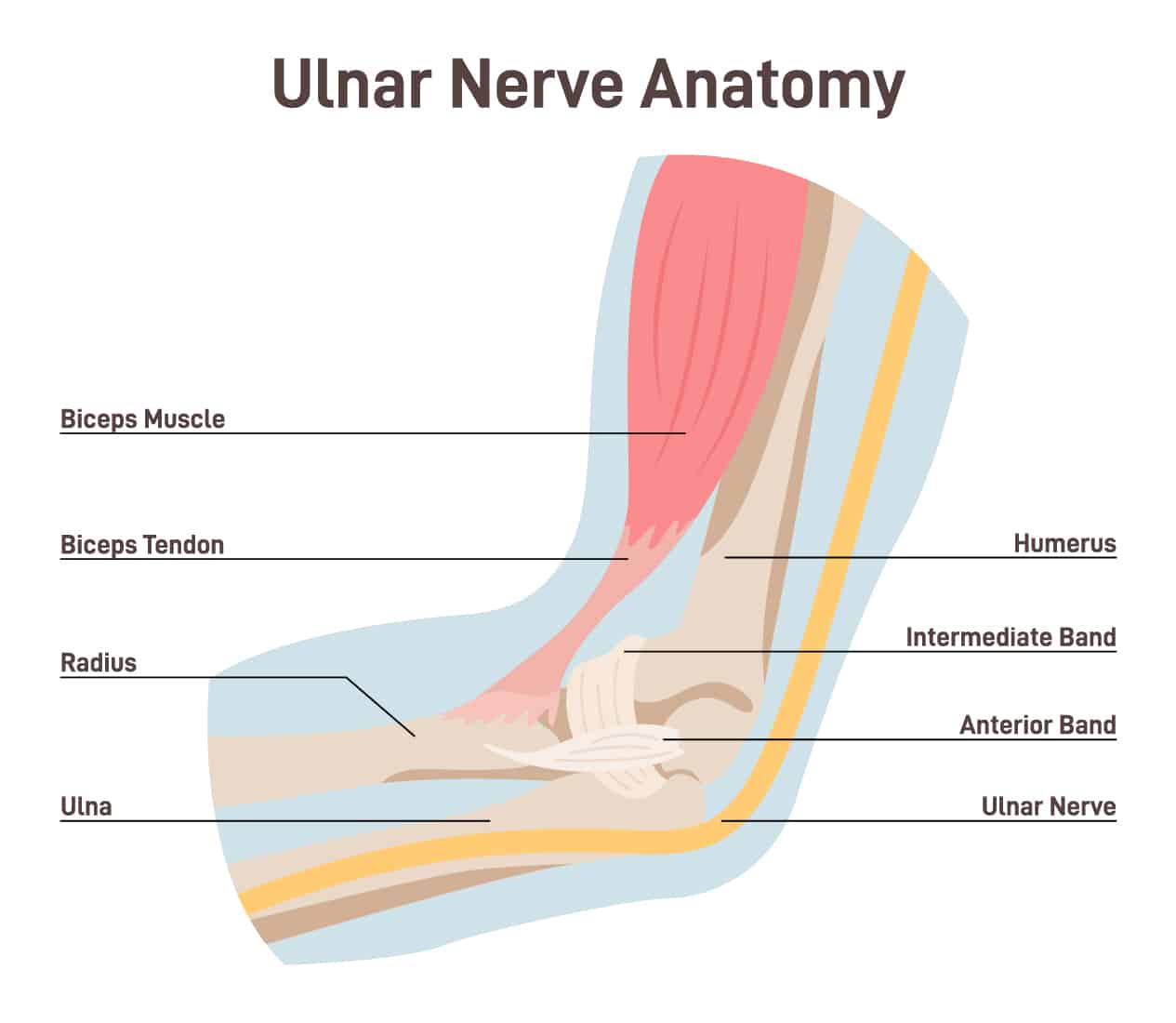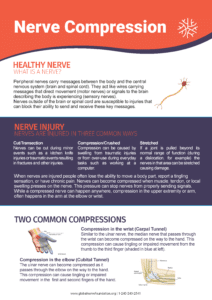Cubital Tunnel
CUBITAL TUNNEL

Slide
Numbness and Tingling caused by the Ulnar Nerve
Numbness and tingling of the hands are common and bothersome symptoms. Such tingling can be temporary. For example, tingling in your arm could result from your arm being under your head as you fall asleep. The tingling symptom is relieved by repositioning your arm. In many cases, however, numbness or tingling in the hands can be persistent and severe and can interfere with daily activities. Other symptoms such as pain, weakness, and dropping things may be present or show up later. In such cases, tingling may signal nerve irritation or damage.
There are several causes for nerve problems, some of which are reversible and some are not. Sensation and motor function to the hand is supplied by three major nerves. These nerves are the median, ulnar, and radial nerves. These nerves reach from the neck, across the elbow, and the wrist, until they reach the fingertips.
There are several causes for nerve problems, some of which are reversible and some are not. Sensation and motor function to the hand is supplied by three major nerves. These nerves are the median, ulnar, and radial nerves. These nerves reach from the neck, across the elbow, and the wrist, until they reach the fingertips.
On the way through the arm and hand, these nerves cross one or more ‘tunnels’. Nerve compression across an anatomic tunnel is called a tunnel syndrome. Nerve compression across the elbow (the cubitus) thus the name Cubital Tunnel Syndrome. Click here to learn more about numbness or pain in your hand that could be caused by Carpal Tunnel Syndrome (or compression of the median nerve in the wrist).
Click below to download our GNF handout on nerve compression
Cubital Tunnel Syndrome
The cubital tunnel is located in the elbow, right where the funny bone is. As a matter of fact, the funny bone is actually the ulnar nerve that goes through the cubital tunnel. Similar to the carpal tunnel, the bottom and sides of the cubital tunnel are formed by bone. The back side of the tunnel is made of a strong ligament. The ulnar nerve passes through this tunnel. It runs through the forearm, across the wrist, and feeds into the ring and little fingers. It supplies feeling to the ring and little fingers and controls the fine muscles of the hand. Cubital Tunnel Syndrome occurs when the nerve is squeezed or stretched in the tunnel, or sometimes when the nerve becomes loose within the tunnel and bounces across the side of the tunnel. This can happen without any particular reason, but sometimes, may be related to deformity, or prolonged pressure.
Dr. Amber Leis explains how to recognize cubital tunnel syndrome.


Resting the elbow on the armrest while driving for long distances, keeping the elbow bent for a long time holding a mobile phone, or going to bed with the hand tucked under the head can cause cubital tunnel syndrome. Symptoms of cubital tunnel syndrome include numbness, tingling, pain, ‘pins-and-needles’, and electric shock-like feeling in the ring and little fingers. These symptoms usually start gradually but may evolve into persistent numbness. They may occur more frequently at night. With time, the hand may get clumsy, and patients notice weakness of grip, and ultimately, the fingers may draw into a claw-like posture.
If you are suffering from compression symptoms, be sure to consult a nerve specialist
Other Causes of Numbness and Tingling
Other tunnels/areas of compression can cause similar symptoms. The symptoms may also be related to pinched nerves in the neck, cervical disc disease, as well as diabetes, and a long list of medical conditions. For this reason, medical evaluation is critical to rule out other causes and determine whether treatment is available.
Sign up to be notified when new educational content is available!
Cubital Tunnel Treatment
Treatment
Non-Surgical Treatment
For cubital tunnel syndrome, it is usually recommended to avoid direct pressure (avoid placing the elbow on the armrest while driving), prolonged use of mobile phones (consider hands-free alternatives), and not to keep the arm bent at night. If symptoms persist or recur, patients may consider non-steroidal anti-inflammatories, but they may not be very effective. Once all options fail, surgery may be considered.
Bracing could be helpful with both carpal and cubital tunnel syndromes.

Bracing can relieve the pressure or irritation of compressed nerves
Surgical Treatment
The surgical procedure for cubital tunnel syndrome typically involves a small incision at the back of your elbow. The surgeon carefully opens up the skin and muscles to access the cubital tunnel—the space where the ulnar nerve travels through.
During the surgery, the surgeon may do one or more of the following:
Following surgery, patients may need to wear a splint or brace to protect the elbow and limit movement during the initial recovery period. Physical therapy exercises are often prescribed to help strengthen the elbow and restore normal function.
It’s important to remember that every individual’s situation is unique, and not everyone with cubital tunnel syndrome will require surgery. Many people find relief with non-surgical treatments, but in some cases, surgery becomes necessary for long-term relief of symptoms.
- Ulnar Nerve Decompression: The surgeon gently releases any tight tissues or structures that are putting pressure on the ulnar nerve. This helps to free up the nerve and relieve the compression.
- Medial Epicondylectomy: In some cases, a small portion of the bony bump on the inside of the elbow (medial epicondyle) might be removed to create more space for the nerve.
- Transposition of the Ulnar Nerve: In more severe cases or if the nerve is unstable, the surgeon may reposition or move the ulnar nerve to a different location in the arm. This new position protects the nerve and reduces the chances of it getting compressed again.
Following surgery, patients may need to wear a splint or brace to protect the elbow and limit movement during the initial recovery period. Physical therapy exercises are often prescribed to help strengthen the elbow and restore normal function.
It’s important to remember that every individual’s situation is unique, and not everyone with cubital tunnel syndrome will require surgery. Many people find relief with non-surgical treatments, but in some cases, surgery becomes necessary for long-term relief of symptoms.
PAGE CONTRIBUTORS
PAGE CONTRIBUTORS

Shafic Sraj, MD
Associate Professor, and Director, System Integration, Dept. of Orthopaedic Hand and Upper Extremity Surgery and Orthopaedic Sports Medicine
West Virginia University

Deana Mercer, MD
Professor, Orthopaedic Surgeon University of New Mexico

Amber Leis, MD
Associate Professor, UCI School of Medicine, Department of Plastic Surgery
University California, Irvine
The content on or accessible through globalnervefoundation.org is for informational purposes only. This information is not a substitute for professional advice or expert medical services from a qualified healthcare provider


